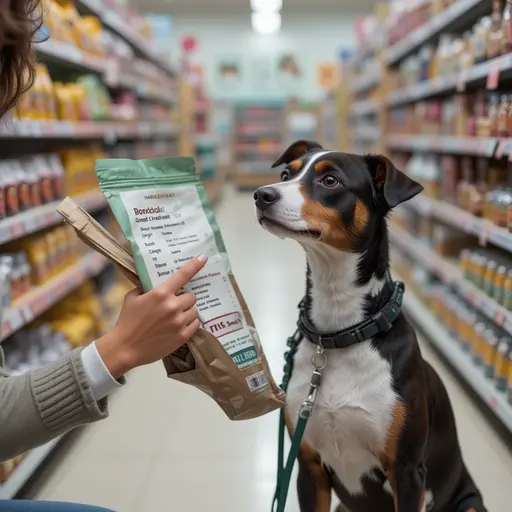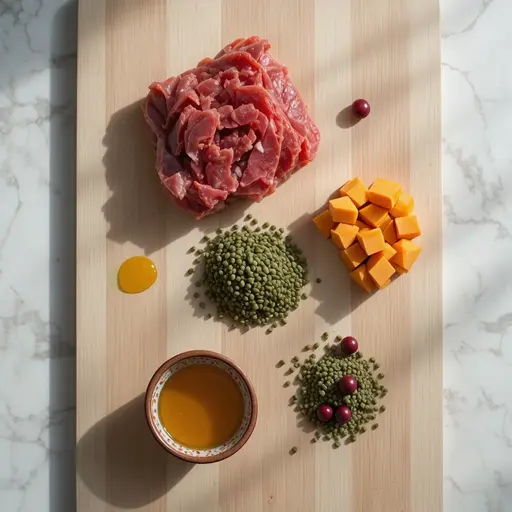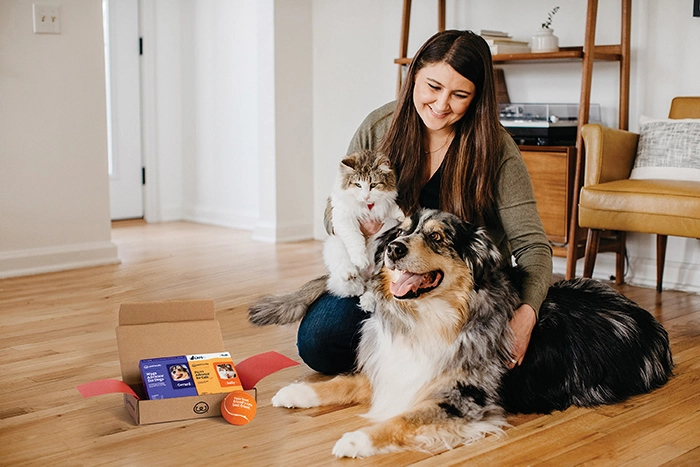The best dog food for allergies typically features limited ingredients or hydrolyzed proteins that minimize immune system reactions. Veterinary-prescribed hydrolyzed diets and high-quality limited-ingredient formulas with novel proteins like kangaroo or duck offer the most reliable relief for allergic dogs.
Food allergies affect up to 10% of all dogs, causing chronic itching, ear infections, and digestive issues that frustrate both pets and owners.
This guide breaks down the science behind allergy-friendly formulas, reviews top-performing options, and walks you through the elimination diet process step-by-step.
Understanding Dog Food Allergies
Food allergies in dogs are immune system overreactions to specific dietary proteins. Unlike food intolerances, which cause digestive upset without immune involvement, true allergies trigger histamine release and inflammatory responses throughout the body.
Your dog’s immune system mistakenly identifies a harmless protein—often from common ingredients like chicken, beef, or dairy—as a threat and mounts a defense.
Common Symptoms That Point to Food Allergies
Watch for these persistent signs that often indicate a food allergy rather than environmental triggers:
- Non-seasonal itching: Scratching that continues year-round, especially around the face, paws, and rear
- Chronic ear infections: Recurring infections that don’t resolve with standard treatments
- Skin infections: Bacterial or yeast infections that keep returning after treatment
- Digestive issues: Vomiting, diarrhea, or excessive gas alongside skin problems
- Red, inflamed skin: Particularly on the belly, armpits, and between toes
Studies show that food allergies account for approximately 20% of all allergic skin disease in dogs. The overlap with environmental allergies makes diagnosis tricky, which is why proper testing through elimination diets remains the gold standard.

The Usual Suspects: Most Common Canine Food Allergens
Research identifies these proteins as the top offenders:
- Beef – Found in 34% of confirmed cases
- Dairy – 17% of cases
- Chicken – 15% of cases
- Wheat – 13% of cases (note: this is a grain protein, not just “grain”)
- Lamb – 5% of cases
- Soy – 5% of cases
Notice that grains themselves are rarely the problem—the protein components within grains cause reactions. This explains why many dogs see no improvement on grain-free diets but thrive on limited ingredient formulas that happen to include rice or oats.
Key Features of the Best Dog Food for Allergies
The best dog food for allergies shares specific characteristics designed to either avoid triggering the immune system or to retrain it. Understanding these features helps you make informed decisions rather than falling for marketing hype.
Limited Ingredient Diets (LID): Simplicity Is Strength
LID formulas contain fewer components, making it easier to identify and avoid allergens. A true limited ingredient diet features:
- One novel protein source: A protein your dog has never eaten before (venison, rabbit, kangaroo)
- One carbohydrate source: Often a simple grain like oatmeal or rice
- Minimal additives: No artificial colors, flavors, or unnecessary preservatives
The simplicity works because it reduces the number of potential allergens your dog encounters. When you feed eight ingredients instead of thirty, you have fewer variables to track during an elimination trial.
Hydrolyzed Protein Diets: Science-Based Solutions
Veterinary therapeutic diets use hydrolyzed proteins—proteins broken down into molecules so small that the immune system cannot recognize them as allergens.
Think of it like dismantling a LEGO castle into individual bricks; your dog’s immune system no longer sees the “castle” (the allergen) it used to attack.
These diets require a prescription because they’re formulated for medical management. Studies show hydrolyzed protein diets resolve clinical signs in 80-90% of food-allergic dogs when fed exclusively for 8-12 weeks.
Novel Proteins: New Foods for Sensitive Systems
Novel proteins are meats your dog’s immune system hasn’t been sensitized to. For dogs raised on chicken and beef, proteins like:
- Kangaroo
- Alligator
- Duck (if not previously fed)
- Rabbit
- Venison
can provide complete nutrition without triggering existing allergies. The key is absolute novelty—if your dog has eaten duck before, it’s not a novel protein for them.
Grain-Free vs. Grain-Inclusive: What the Data Shows
Despite popular belief, grain allergies are rare. Only about 1% of dogs with food allergies react to corn, and wheat allergies involve the protein fraction, not the carbohydrate.
Grain-inclusive formulas with limited, simple grains often work better than grain-free options loaded with multiple legumes and potatoes.
Grain-free diets have come under scrutiny for potential links to dilated cardiomyopathy (DCM) in certain breeds. Unless your dog has a confirmed grain allergy, grain-inclusive limited ingredient diets are generally safer and more effective.
AAFCO Statement: The Non-Negotiable Quality Mark
Any food you consider must have an Association of American Feed Control Officials (AAFCO) statement confirming it provides “complete and balanced nutrition” for your dog’s life stage. This ensures the formula meets minimum nutritional standards, preventing deficiencies during long-term feeding.

Top 5 Best Dog Food for Allergies: Detailed Reviews
These selections represent different categories of allergy management, each serving specific dietary needs and budgets. We evaluated based on ingredient quality, manufacturing controls, clinical evidence, and real-world results.
1. Hill’s Prescription Diet z/d Original Skin/Food Sensitivities
Why it works: Hydrolyzed chicken liver provides protein in a form too small to trigger reactions. This veterinary therapeutic diet undergoes rigorous quality control to prevent cross-contamination.
Key features:
- Hydrolyzed protein (molecular weight < 3,000 Daltons)
- Single carbohydrate source (corn starch)
- Enhanced omega-3 and omega-6 fatty acids for skin health
- Clinically proven to reduce skin lesions in 21 days
Best for: Dogs with severe, confirmed food allergies; dogs who haven’t responded to over-the-counter LID formulas
Considerations: Requires veterinary prescription; premium pricing ($90-110 for 25 lbs); corn-based carbohydrate may concern some owners
Our take: The gold standard for difficult allergy cases. The hydrolysis process makes this the most reliable option for dogs who react to multiple proteins.
2. Royal Canin Veterinary Diet Hydrolyzed Protein HP
Why it works: Similar hydrolyzed soy protein approach with added skin barrier support. Royal Canin’s strict manufacturing protocols exceed industry standards for allergen control.
Key features:
- Hydrolyzed soy protein (non-animal option for dogs with meat sensitivities)
- B vitamins and amino acids to rebuild the skin barrier
- Omega-3 EPA/DHA from fish oil
- 92% of dogs show improvement within 4 weeks
Best for: Dogs with both skin and gastrointestinal symptoms; dogs needing soy-based protein
Considerations: Veterinary prescription required; soy as the main protein may not suit all owners; $95-120 for 25 lbs
Our take: Excellent alternative to Hill’s z/d, especially for dogs with concurrent digestive issues. The skin barrier complex addresses the secondary skin damage caused by chronic scratching.
3. Natural Balance L.I.D. Limited Ingredient Diets Sweet Potato & Venison
Why it works: Uses venison as a novel protein for most dogs, paired with a single carbohydrate source. Natural Balance’s “Buy with Confidence” program tests every batch for contaminants and allergens.
Key features:
- Premium venison protein
- No grains, artificial flavors, or colors
- Complete nutrition for all life stages
- Available without a prescription
Best for: First-time elimination diet trials; budget-conscious owners; dogs with suspected but unconfirmed food allergies
Considerations: Not suitable for dogs previously exposed to venison; potato-heavy formula may not suit all dogs; 25 lbs costs $60-75
Our take: The most accessible entry point for food allergy management. While not as foolproof as hydrolyzed diets, it works for 60-70% of mild to moderate cases when fed exclusively.
4. Blue Buffalo Basics Skin & Stomach Care Duck & Potato
Why it works: Duck provides a novel protein alternative to chicken, while pumpkin and fish oil support digestive and skin health. Blue Buffalo’s “LifeSource Bits” adds antioxidants without common allergens.
Key features:
- Real duck is the first ingredient
- Pumpkin for gentle digestion
- Omega-3 and omega-6 fatty acids
- No chicken, beef, corn, wheat, soy, dairy, or eggs
Best for: Dogs reacting specifically to chicken; owners wanting a grain-free option with nutritional enhancements
Considerations: Contains multiple ingredients beyond the basics; not a true LID; $65-80 for 24 lbs
Our take: A solid middle ground between prescription diets and basic LIDs. The added digestive support helps dogs with sensitive stomachs transition more easily.
5. JustFoodForDogs Venison & Squash Recipe
Why it works: Human-grade venison and whole vegetables in a minimally processed formula. The ingredient list is so short you can count the items on one hand, eliminating hidden allergens.
Key features:
- Five whole-food ingredients: venison, squash, sweet potatoes, Brussels sprouts, cranberries
- No preservatives, fillers, or synthetic vitamins
- Made in USDA-inspected kitchens
- Board-certified veterinary nutritionist formulated
Best for: Owners wanting to avoid processed foods; dogs who refuse kibble; dogs with suspected additive sensitivities
Considerations: Requires freezer space; significantly more expensive ($150+ for 30 lbs equivalent); shorter shelf life
Our take: While not a true hydrolyzed diet, the ultra-simple ingredient list and whole-food preparation eliminate many variables that trigger sensitive dogs. Perfect for owners prioritizing ingredient quality over convenience.

How to Choose the Right Formula for Your Dog
Selecting the right allergy-friendly food requires a systematic approach. Jumping between formulas randomly can worsen symptoms and make diagnosis impossible.
Step 1: The Elimination Diet Protocol
The elimination diet is the only reliable method to diagnose food allergies. Here’s the veterinary gold-standard process:
- Choose a diet: Select either a hydrolyzed prescription diet or a novel protein LID
- Feed exclusively for 8-12 weeks: No treats, no table scraps, no flavored medications, no toothpaste with animal proteins
- Monitor symptoms: Keep a daily log of itching, ear health, and stool quality
- Re-challenge: If symptoms improve, reintroduce old foods one at a time to confirm the trigger
Critical rule: If you switch formulas during the trial, you must restart the 8-12 week clock. Partial compliance yields zero reliable results.
Step 2: Reading Labels Like a Veterinary Dermatologist
Learn to decode ingredient panels. “Chicken meal” and “chicken” are both chicken proteins. “Animal digest” could contain multiple unspecified proteins. Watch for these hidden allergen sources:
- Natural flavors: Often derived from common proteins
- Meat by-products: Unspecified animal sources
- Generic “meat meal”: Could be beef, chicken, or pork
- Probiotics grown on dairy: Some cultures use milk proteins as growth media
The best dog food for allergies lists every ingredient specifically. If you see vague terms, choose another formula.
Step 3: Working With Your Veterinarian
Your vet provides essential guidance through this process. They can:
- Prescribe therapeutic diets not available in retail
- Rule out environmental allergies and other conditions
- Provide adjunct therapies (antihistamines, ear cleaners) during the trial
- Interpret results and plan long-term management
Expect to spend $200-400 on the diagnostic process, including exams and potentially prescription diets. This investment prevents years of ineffective treatment and unnecessary suffering.
Step 4: Transitioning Foods Without Triggering Symptoms
Switch to the new diet gradually over 7-10 days:
- Days 1-3: 25% new food, 75% old food
- Days 4-6: 50% new food, 50% old food
- Days 7-9: 75% new food, 25% old food
- Day 10: 100% new food
If symptoms worsen during transition, move more slowly. Some extremely sensitive dogs need 14-day transitions.
Step 5: The Re-Challenge Phase (Most Important Step)
After 8-12 weeks of improvement, you must reintroduce old ingredients one at a time. Feed a small amount of pure chicken for 3 days, then watch for symptoms over the next week. No reaction? Move to beef. This process identifies the specific trigger and expands your dog’s safe food options.
Skipping this step leaves you feeding an expensive therapeutic diet indefinitely when you might only need to avoid one or two ingredients.
Homemade vs. Commercial: Making the Right Choice
The appeal of homemade diets is understandable—you control every ingredient. However, they carry significant risks for allergy management.
Pros of Homemade Allergy Diets
- Complete ingredient control: Know exactly what enters your dog’s bowl
- Freshness: No processing or preservatives
- Customization: Adjust proteins and carbs based on results
Cons That Can’t Be Ignored
- Nutritional deficiencies: 95% of homemade diets lack essential nutrients without precise supplementation
- Cross-contamination risk: Home kitchens lack the allergen-control protocols of therapeutic food facilities
- Time and cost: Sourcing ingredients and preparing balanced meals is expensive and labor-intensive
- No clinical testing: You can’t verify the diet is truly hypoallergenic
When Homemade Makes Sense
Consider homemade only if:
- Your dog reacts to every commercial option, including hydrolyzed diets
- You work with a board-certified veterinary nutritionist (not a “pet nutritionist”)
- You commit to using a recipe formulation service like BalanceIT
Reality check: Veterinary dermatologists report that most dogs fail homemade allergy diets due to accidental cross-contamination or nutritional imbalances. The best dog food for allergies almost always comes from a manufacturer with strict quality controls.
Beyond Food: Holistic Allergy Management
Even the best dog food for allergies works better when combined with environmental controls. Allergic dogs often have multiple triggers.
Environmental Controls to Implement
- Weekly baths: Use a gentle, hypoallergenic shampoo to remove environmental allergens from the skin
- Foot soaks: Rinse paws after walks to remove pollen and grass allergens
- HEPA filtration: Reduces dust mites and pollen in your home
- Wash bedding weekly: Hot water (130°F+) kills dust mites
- Flea prevention: Flea allergy dermatitis mimics food allergy symptoms
Supplements That Support Allergy Management
After completing your food trial, consider these evidence-supported additions:
- Omega-3 fatty acids (EPA/DHA): 100-150 mg/kg daily reduces skin inflammation
- Vitamin E: Acts as an antioxidant and supports the skin barrier
- Quercetin: Natural antihistamine, though canine dosing research is limited
- Probiotics: Single-strain, dairy-free options may modulate immune response
Always introduce supplements one at a time after your dog is stable on the new diet.
The Importance of Regular Grooming
Allergic dogs benefit from professional grooming every 4-6 weeks. A groomer can:
- Remove dead skin and allergens from the coat
- Trim hair around infected ears for better medication penetration
- Identify skin changes you might miss
Between groomings, brush your dog weekly to distribute natural oils and remove allergens.
Special Considerations for Different Life Stages
Puppies, adults, and seniors have unique needs when managing food allergies.
Puppies with Allergies
Puppies can develop allergies as early as six months. The challenge? They need precise nutrition for growth. Never feed a puppy a homemade diet for allergies without a veterinary nutritionist.
Hydrolyzed protein puppy formulas exist and provide complete nutrition while managing symptoms. The best dog food for allergies in puppies must state that it meets AAFCO standards for growth.
Adult Dogs in Prime Years
Adult dogs have the most options. Focus on identifying triggers early to prevent chronic skin changes. Scarring from long-term scratching can become permanent, making future flare-ups worse even after dietary control.
Senior Dogs with New-Onset Allergies
Senior dogs developing new allergies may have underlying conditions like hypothyroidism or Cushing’s disease that complicate diagnosis. Work with your vet for complete screening. Senior-specific LIDs include joint support and antioxidants that benefit older allergic dogs.
Red Flags: When to Seek Immediate Veterinary Care
While managing food allergies at home is possible, certain situations require professional intervention:
- Sudden swelling of face or muzzle: Could indicate anaphylaxis
- Open, oozing skin lesions: Risk of severe bacterial infection
- Ear infections that don’t improve after 2 weeks: May need prescription medication
- Weight loss despite good appetite: Rules out other systemic diseases
- Vomiting or diarrhea lasting more than 48 hours: Risk of dehydration
Food allergies rarely cause emergencies, but the secondary complications can become serious without treatment.
The Bottom Line: Your Action Plan for Allergy Relief
Managing your dog’s food allergies is a marathon, not a sprint. Success requires patience, precision, and partnership with your veterinarian. Here’s your starting point:
- Schedule a veterinary appointment to rule out other conditions
- Choose either a prescription hydrolyzed diet or novel protein LID based on severity
- Commit to an 8-12 week elimination trial with zero cheating
- Track symptoms meticulously with photos and notes
- Re-challenge ingredients to identify specific triggers
- Transition to a long-term maintenance diet based on results
The best dog food for allergies isn’t the most expensive or trendiest—it’s the one that reliably controls your dog’s symptoms while providing complete nutrition. For most dogs, that means starting with a hydrolyzed prescription diet, then graduating to a commercial LID once triggers are identified.
FAQs About Dog Food Allergies
Can dogs develop food allergies later in life?
Yes. Food allergies typically develop after months or years of eating the same protein. A dog who’s eaten chicken without issues for five years can suddenly develop an allergy. This happens because the immune system requires repeated exposure before mounting an allergic response. If your senior dog develops itching without seasonal patterns, food allergy should be on your diagnostic list.
How long until I see improvement on a new diet?
Most owners notice reduced itching within 3-4 weeks on a hydrolyzed diet, but skin needs time to heal. The full 8-12 week trial is essential because inflammatory cycles take time to resolve. Dogs with chronic ear infections may need the full 12 weeks before infections stop recurring. Track progress weekly with photos—improvement can be subtle at first.
Are grain-free diets always better for allergies?
Absolutely not. This is one of the most damaging myths in pet nutrition. Grain allergies are rare; protein allergies are common. Grain-free diets often substitute legumes (peas, lentils) that contain novel proteins dogs may react to. The FDA is investigating links between grain-free diets and heart disease in dogs. Unless your dog has a confirmed grain protein allergy, grain-inclusive limited ingredient diets are safer and often more effective.
Can supplements help while I’m doing a food trial?
Only use vet-approved supplements during an elimination trial. Omega-3 fatty acids can reduce skin inflammation and are safe to add. Probiotics may help gut health, but choose a dairy-free, single-strain product. Avoid “allergy support” chews—they often contain chicken, beef, or unidentified proteins that ruin your trial. Keep it simple: food and possibly omega-3s only.
My dog hates the prescription diet. What now?
This is common. Try:
- Warming the food slightly to enhance the aroma
- Adding a small amount of water to create gravy
- Mixing in a tiny amount of canned pumpkin (not pie filling)
- Asking your vet about alternative hydrolyzed flavors or brands
If your dog absolutely refuses, a novel protein LID is your next best option. Some dogs prefer the taste of Natural Balance or Blue Buffalo Basics over prescription diets.
How much does managing food allergies cost annually?
Expect $800-2,500 per year, depending on your approach:
- Prescription hydrolyzed diet: $1,200-1,800 annually
- Over-the-counter LID: $600-900 annually
- Homemade with nutritionist: $1,500-3,000 annually
- Veterinary monitoring: $200-400 annually
This seems expensive until you compare it to treating chronic ear infections, skin infections, and ongoing medication costs, which can exceed $3,000 annually.
Can I feed my allergic dog treats?
During the initial 8-12 week elimination trial, no treats at all. Use the kibble itself as treats. After identifying safe ingredients, you can make treats from those same ingredients. If duck is safe, bake thin slices of duck breast. If potatoes are safe, dehydrate sweet potato slices. Commercial “hypoallergenic” treats often contain multiple proteins—avoid them
Conclusion
Finding the best dog food for allergies transforms your dog’s life from itchy and uncomfortable to healthy and happy.
The path forward is clear: start with a scientifically-backed elimination diet using either a hydrolyzed prescription formula or a strict novel protein diet, work closely with your veterinarian, and commit to the full 8-12 week process.
Remember, 90% of dogs show dramatic improvement when the correct diet is identified and fed exclusively.
Your patience during the diagnostic phase pays off with years of relief, fewer vet visits for skin and ear infections, and a dog who finally feels comfortable in their own skin.
Take the first step today. Explore veterinary-recommended hydrolyzed diets and high-quality limited ingredient formulas that match your dog’s specific needs. Relief is closer than you think







